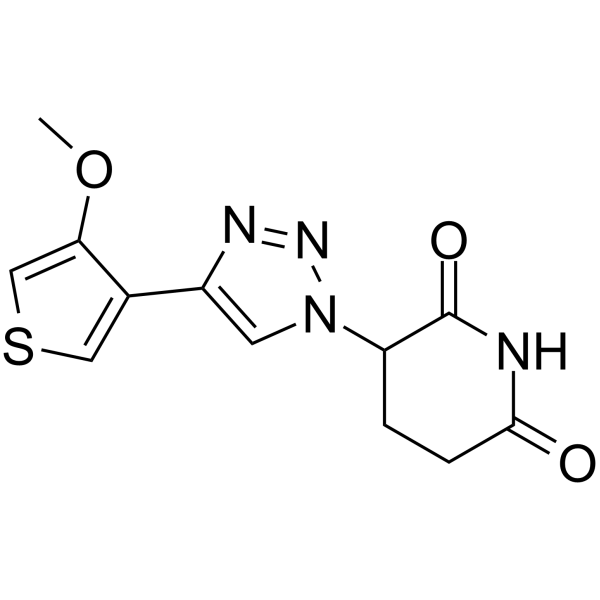2367619-87-0
| Name | FPFT-2216 |
|---|
| Description | FPFT-2216, a “molecular glue” compound, degrades phosphodiesterase 6D (PDE6D), zinc finger transcription factors Ikaros (IKZF1), Aiolos (IKZF3), and casein kinase 1α (CK1α). FPFT-2216 can be used for the research of cancer and inflammatory disease[1][2]. |
|---|---|
| Related Catalog | |
| Target |
PDE6D CK1α IKZF1 IKZF3 |
| In Vitro | FPFT-2216 (1 μM; 5 hours) is able to degrade PDE6D, in addition to its known targets IKZF1, IKZF3, and CK1α in MOLT4 cells[1]. FPFT-2216 (1 μM; 0 h, 2 h, 4 h, 6 h, 16 h, 24 h) shows complete degradation of PDE6D within 2 h, and the degradation of PDE6D persists for at least 24 h in MOLT4 cells[1]. FPFT-2216 (0 nM, 1.6 nM, 8 nM, 40 nM, 200 nM, 1 μM; 4 h) exhibits over 50% degradation of PDE6D at a dose of 8 nM, while maximum degradation of PDE6D along with IKZF1, IKZF3, and CK1α at a dose of 200 nM in MOLT4 cells[1]. FPFT-2216 does not impede the growth of KRASG12C-dependent MIA PaCa-2 cells[1]. FPFT-2216 (10, 20, 40 µM; 14 or 24 h) highly up-regulates the production of IL-2 although it is less potent than that of Pomalidomide in Naive CD4+ T cells[2]. FPFT-2216 (10 µM; 14 or 24 h) degrades IKZF1 and CK-1α among ubiquitin–proteasomal degradative substrates of immunomodulatory drugs (IMiDs) in Naive CD4+ T cells[2]. Western Blot Analysis[1] Cell Line: MOLT4 cells Concentration: 1 μM Incubation Time: 0 h, 2 h, 4 h, 6 h, 16 h, 24 h Result: Showed complete degradation of PDE6D within 2 h, and the degradation of PDE6D persisted for at least 24 h. Western Blot Analysis[1] Cell Line: MOLT4 cells Concentration: 0 nM, 1.6 nM, 8 nM, 40 nM, 200 nM, 1 μM Incubation Time: 4 h Result: Exhibited over 50% degradation of PDE6D at a dose of 8 nM, while maximum degradation of PDE6D along with IKZF1, IKZF3, and CK1α at a dose of 200 nM. |
| In Vivo | FPFT-2216 (30 mg/kg; p.o. or i.p.) induces significant degradation of CK-1α, and IKZF1 in CRBNI391V mice[2]. Animal Model: CRBNI391V mice[2] Dosage: 30 mg/kg (solubilized in 0.5% carboxymethylcellulose/sodium and 0.25% Tween 80) Administration: p.o. or i.p. Result: Induced significant degradation of CK-1α, and IKZF1. |
| References |
| Molecular Formula | C12H12N4O3S |
|---|---|
| Molecular Weight | 292.31 |
